
In Part 1 of our Bike Fit Guide, we went through the basic terms and measurements that you’ll see if you’re looking at a geometry chart for any given bike. We also talked a bit about which of those measurements tend to be the most useful; which ones give you an idea of how the bike will fit; and which ones will give you an idea of how the bike might ride.
So with that foundation in place, let’s look at a few real-world examples and see what kind of conclusions we can draw (and can’t draw) from looking at the geometry charts for some comparable bikes.
First, let’s look at some longer-travel trail bikes that have 27.5” wheels. We’ll look at a Santa Cruz Bronson, a Pivot Mach 6, and a Specialized Stumpjumper FSR 650b.
Here’s the chart for the 2017 Santa Cruz Bronson:
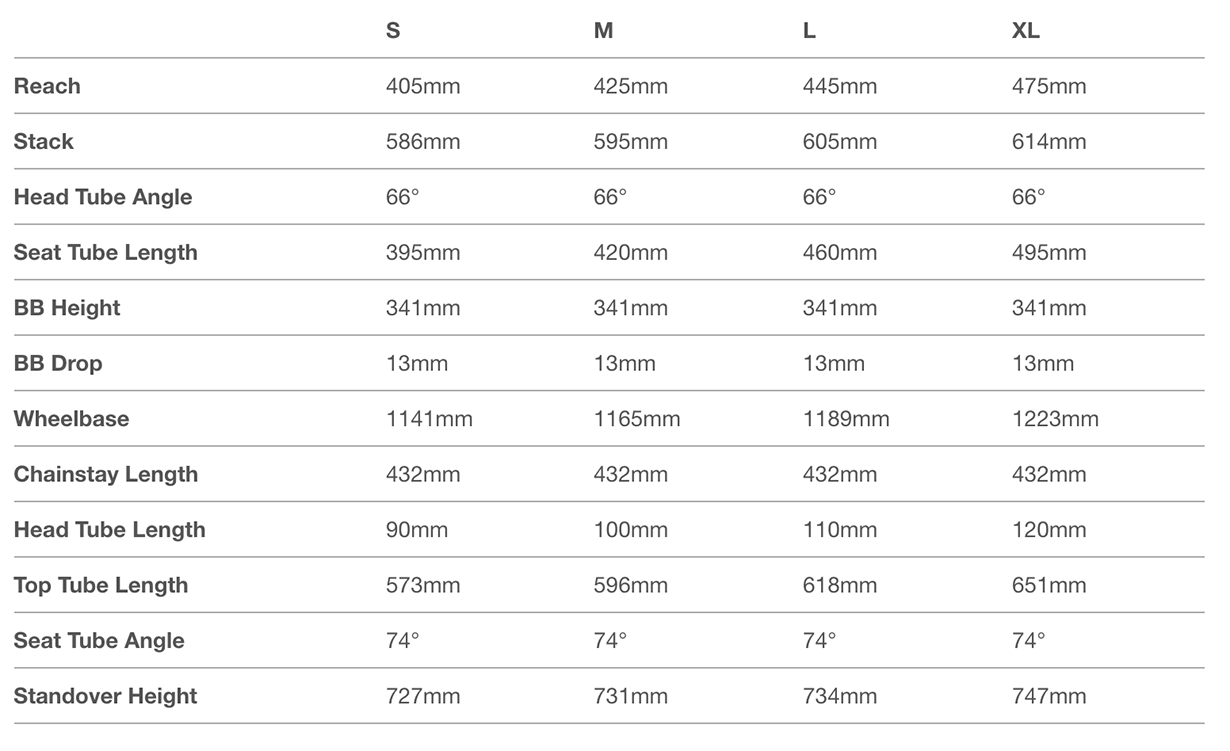
Here’s the chart for the 2017 Pivot Mach 6:
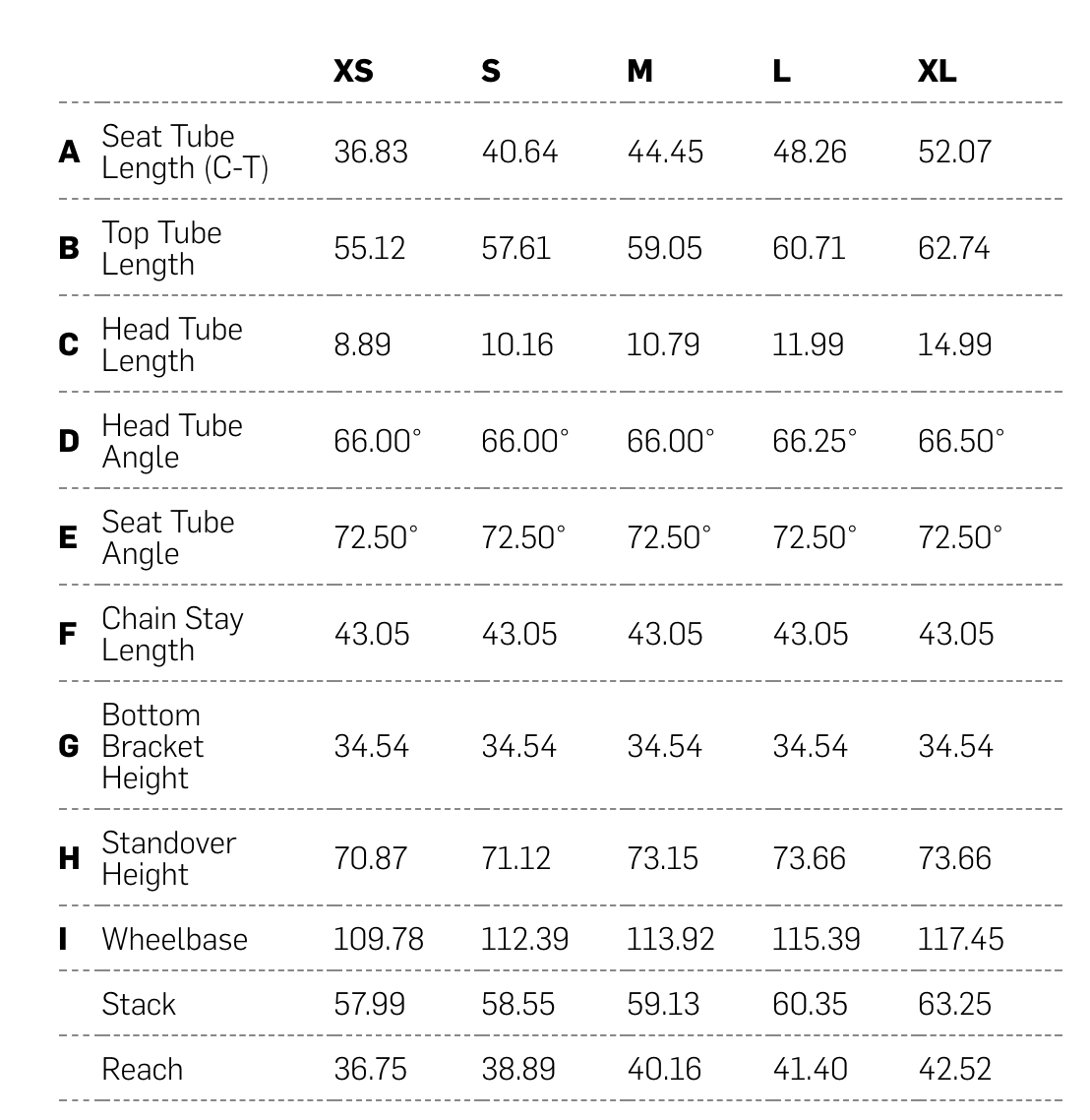
Here’s the chart for the 2017 Specialized Stumpjumper:
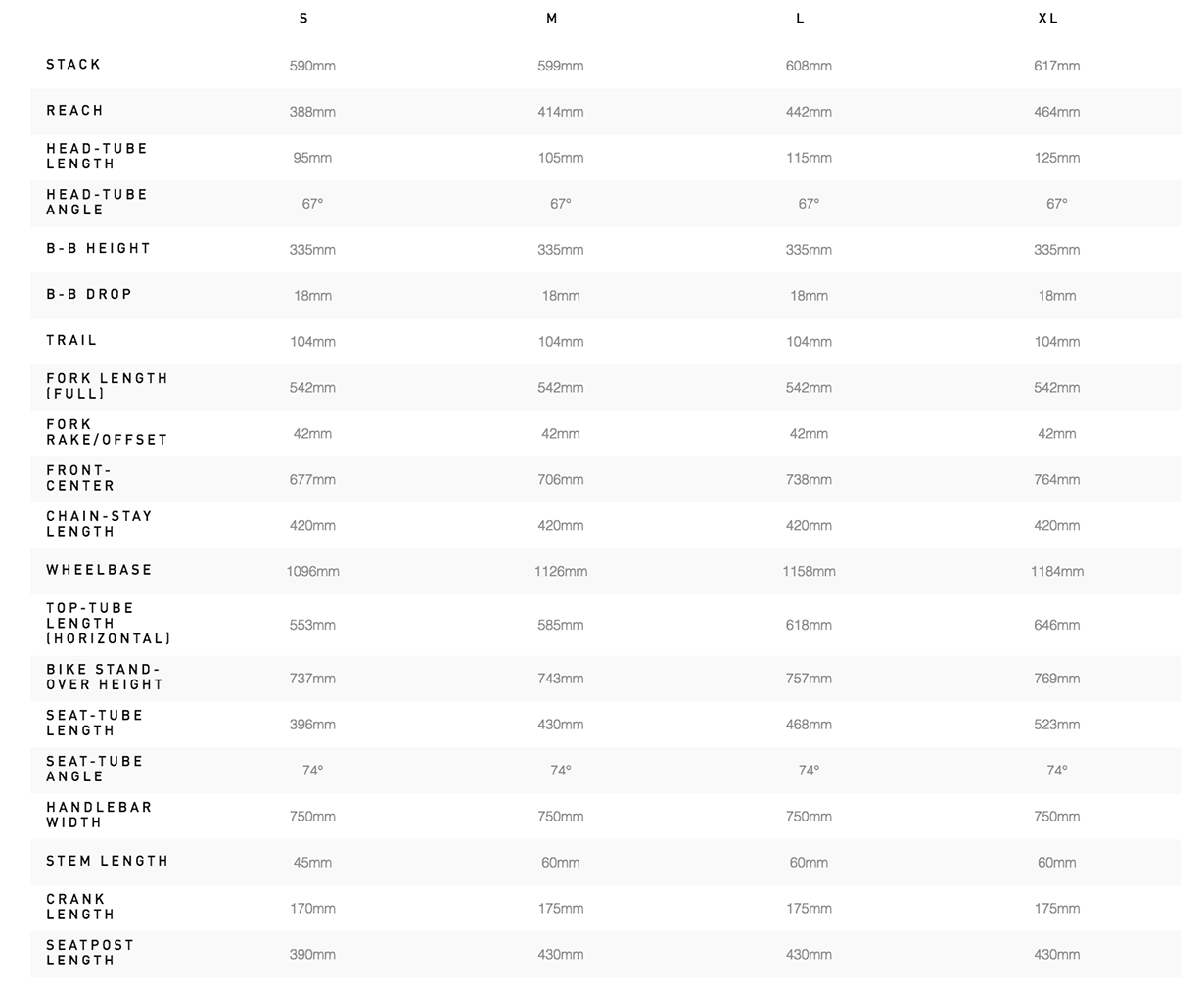
What Conclusions Can We Draw about Fit?
At the outset, we know that all three bikes are running 27.5” wheels. We also know (from looking at the parts specs for each bike), that the Bronson and Stumpjumper both run a 150 mm fork, while the Mach 6 comes stock with a 160 mm fork. All three bikes have similar rear travel — 150 mm for the Bronson and Stumpjumper, and 155 mm for the Mach 6. So right off the bat, we know that these three bikes are more or less in the same category, and it makes sense to compare them.
#1: Reach
Diving into the geometry charts, we’ll start by looking at how the bikes might fit, and the first number we’ll look at is the reach. Just for the purposes of this discussion, I’m going to look at a size Medium for each bike.
The reach of a size Medium Bronson is listed as 425 mm, it’s 401.6 mm on the Mach 6, and it’s 414 mm on the Stumpjumper. So our first conclusion is that, at least while standing, the Bronson will feel like the biggest bike of the three. It’s noteworthy that the Bronson is about 23 mm longer than the Mach 6, which is quite a bit (for you imperialists, that’s almost an inch).
#2: Effective Top Tube Measurements
Next, we’ll look at the effective top tube measurements, which will give an idea of how big the bikes will feel while seated. Again, the Bronson is the longest at 596 mm, but the Mach 6 is only slightly shorter at 590.5 mm, while the Stumpjumper measures the shortest at 585 mm.
So how is it that the Mach 6 has the shortest reach measurement, but not the shortest top tube measurement?
Remember that reach is the horizontal distance from the bottom bracket to the top of the head tube, and the top tube is measured horizontally from the top of the head tube to the seat tube. So for the top tube measurement, the slacker and more angled the seat tube is, the longer the top tube will be. But the seat tube angle has no effect on the reach measurement. So if we compare the seat tube angles of the three bikes, we’ll see that the Mach 6 has the slackest seat tube angle at 72.5° (vs. 74° on the other two bikes). And, in large part, it’s that slacker seat tube that makes the top tube longer on the Mach 6 (relative to the reach).
Conclusions on Fit
We know that, for a given size, the Bronson will feel the biggest both while standing and while in the saddle. It’s significantly longer in all measurements than either of the other bikes. The Mach 6 is pretty short (particularly in the reach department) so it might be worth considering sizing up, especially if you’re between sizes. And while the Stumpjumper isn’t as short as the Mach 6, it’s still not a particularly long bike. So using our size-Medium examples, I suspect someone that’s 5’10” might be fine on a Medium Bronson, but that same person might consider bumping up to a Large Stumpjumper.
What Conclusions Can We Draw about Ride Qualities?
Now let’s take a look at some of the other numbers to see what conclusions we might be able to make as to how the bikes will likely ride.
#1: Head Tube Angles
Let’s start by comparing head tube angles; we have a 66° head tube angle on the Bronson and Mach 6, and a slightly steeper 67° head tube angle and the Stumpjumper. So at first glance, I’d expect the Bronson and Mach 6 to be a bit more stable at speed, but the Stumpjumper might feel a bit more maneuverable on switchbacks and in other tight situations. But other measurements can affect stability and maneuverability, so we’re not done just yet….
#2-3: Chainstay Lengths & Wheelbases
Next, we’ll look at chainstay lengths and wheelbases (again, I’m just looking at the Medium sizes as a reference point). The chainstays on the Bronson are 432 mm. They’re 430.5 mm on the Mach 6, and the Stumpjumper is by far the shortest at 420 mm. Shorter chainstays make it a lot easier to get the front wheel off the ground, and they can make the bike feel a bit more playful. But they also mean that the rider’s weight is biased a bit more toward the rear, so the bike tends to corner differently with short stays. This is largely a personal preference thing, but we at least know that in terms of chainstay length, the Mach 6 and Bronson are similar, while the Stumpjumper is considerably shorter.
When it comes to wheelbase, the Medium Bronson is the longest at 1165 mm, and this shouldn’t come as any surprise — it has the longest reach, the longest chainstays, and it’s tied for the slackest head angle; all of those numbers add up to a long wheelbase. Also unsurprisingly, the Mach 6 comes in second at 1139.2 mm, and the Stumpjumper (with it’s short stays, moderate reach, and steeper headtube angle) comes in the shortest at 1126 mm.
The takeaway here is that the Bronson is a substantially bigger bike — its wheelbase is almost 40 mm longer than the Stumpjumper. The longer Bronson will likely be more stable at speed, and longer bikes tend to be a little more comfortable plowing through super rough trails. But, at the risk of stating the obvious, bigger bikes feel less maneuverable, and it’ll likely take more body english to make the Bronson navigate twisty trails than it would on the Stumpjumper. And of course, the Mach 6 would likely fall somewhere in between those two.
#4: Bottom Bracket Drop
We can also take a quick look at the bottom bracket drop to see if there’s anything noteworthy there. The Bronson has a 13 mm drop, and a stated bottom bracket height of 341 mm. The Mach 6 doesn’t list bottom bracket drop, but it shows a bottom bracket height of 345.4 mm. The Stumpjumper lists the drop as 18 mm, and a stated height of 335 mm. So we see that the Stumpjumper is the lowest, and the Mach 6 is the tallest. I’d expect this would help cement the Stumpjumper as the bike (among these three) that’ll carve through corners the best, and the Mach 6 might be preferable if you’re pedaling up lots of rocky climbs where having a bit more clearance is preferable.
But speaking of climbing, from our discussion on fit up above, we know that the Mach 6 has the slackest seat tube angle, so people with long legs that need to put their seat up pretty high will likely end up with a saddle that’s substantially rearward on the bike. That rearward saddle position can be less than ideal for pedaling up steep climbs, since it can make it harder to keep weight over the front wheel, and the saddle position relative to the pedals can be less efficient. But, as we discussed in Part 1, we only know the effective seat tube angles for these three bikes; none of them list the actual seat tube angles. So it’s tough to draw any firm conclusions from these charts regarding the likely position of a raised saddle.
Conclusions on How the Bikes Might Ride
The Bronson is the slackest and longest of our three bikes by a decent margin, so I’d expect it to be the most stable at speed, while also feeling the most cumbersome on slower, mellower trails. With a slacker headtube, somewhat longer chainstays, and a pretty rangy wheelbase, the Bronson seems like it’s built for higher-speed pursuits.
At the other end of the spectrum, the Stumpjumper is shorter all around, has a steeper head tube angle, and a lower bottom bracket. All of that adds up to a bike that I’d expect to work really well on tighter trails, particularly those with lots of mid-speed corners. This looks like a bike that might corner really, really well, but that might feel like less of a monster truck when speeds open up and the trail gets rough.
I’d expect the Mach 6 to fall somewhere in between the Bronson and the Stumpjumper. On the one hand, it has a fairly slack head tube angle and a not-super-short wheelbase and chainstays. On the other hand, the short reach might make the bike feel small (which also tends to feel less stable), and the high-ish bottom bracket can make the bike feel a bit more top heavy and tippy in corners. So the Mach 6 is a tougher bike to draw a firm conclusion on than the other two.
Example #2: Mid-Travel 29ers
We went through the first three bikes with a fair amount of detail, which can be helpful, but it’s also pretty time consuming. Ideally, a quick glance at a geometry chart should be all you need to get a general sense of the bike, so let’s go over another set of three bikes, but this time we’ll just breeze through the numbers and draw some quick conclusions.
This time, let’s look at some mid travel 29ers: the Salsa Horsethief, the Specialized Camber, and the Kona Process 111.
Here’s the chart for the 2017 Salsa Horsethief:
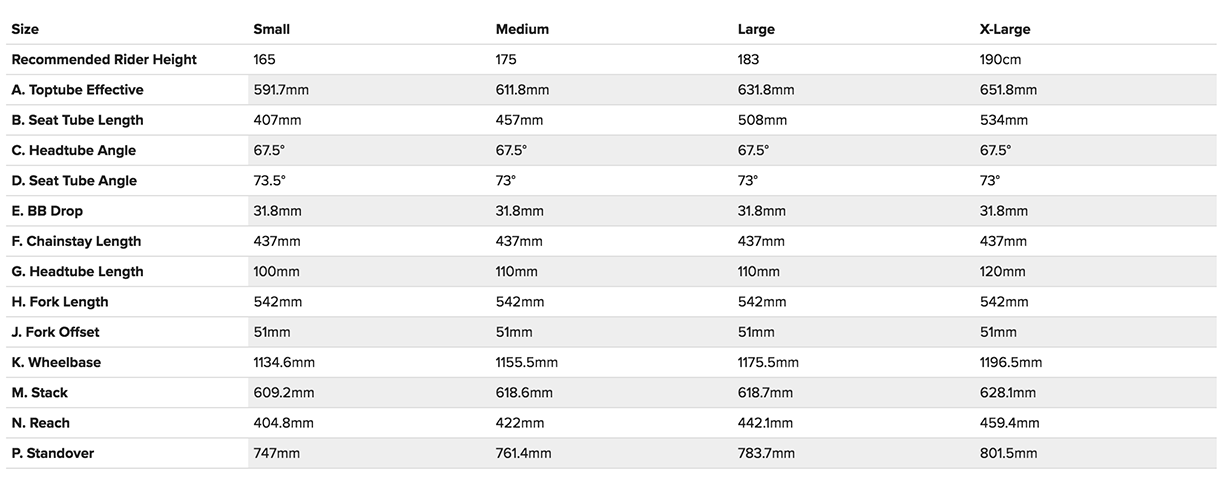
Here’s the chart for the 2017 Specialized Camber:

Here’s the chart for the 2017 Kona Process 111:
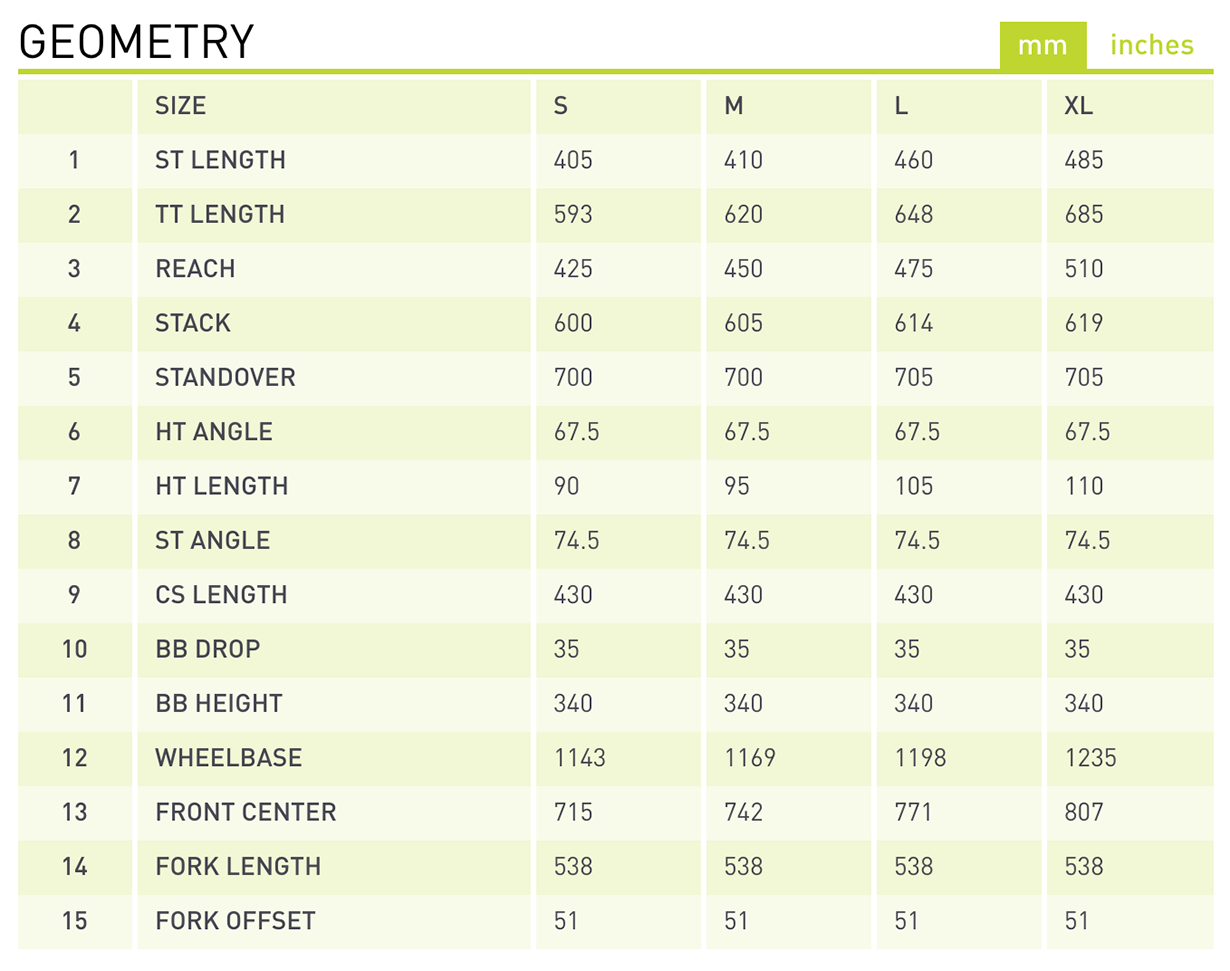
First, I’ll pull out a few relevant numbers for each of those bikes. For the purposes of this example, we’ll again compare size Medium bikes:
Reach:
Horsethief: 422 mm
Camber: 427 mm
Process 111: 450 mm
Effective Top Tube length:
Horsethief: 611.8 mm
Camber: 590 mm
Process 111: 620 mm
Wheelbase:
Horsethief: 1155.5 mm
Camber: 1135 mm
Process 111: 1169 mm
Head Tube Angle:
Horsethief: 67.5°
Camber: 68.5°
Process 111: 67.5°
Seat Tube Angle:
Horsethief: 73°
Camber: 75°
Process 111: 74.5°
Bottom Bracket Drop:
Horsethief: 31.8 mm
Camber: 42 mm
Process 111: 35 mm
So, what conclusions can we draw here?
The first and most obvious one is that the Process 111 is a looong bike. Its reach, top tube, and wheelbase measurements are all significantly longer than either the Horsethief or the Camber. That means a size Medium Process 111 will likely feel more equivalent to a size Large Horsethief or Camber. It also means that the size Small Process 111 (the smallest size Kona offers) really isn’t that small.
At the other end of the spectrum, really tall people can rejoice — the XL Kona Process 111 (the largest size they make) is similar in size to the XXL Camber, and it’s significantly longer than the largest Horsethief.
In terms of ride characteristics, we can see that the Horsethief and Process 111 both have a 67.5° head tube angle, which is a full degree slacker than the Camber (68.5° head angle). So the Horsethief and Process 111 would probably be a bit more stable at speed, but feel a little less maneuverable in tight spots.
But we should also note that the Camber comes with a 120 mm travel fork, while both the Horsethief and Process 111 come with 130 mm travel forks. So that shorter travel fork means the Camber has a lower front end, which in turn means that the head angle is a bit steeper. We can speculate that increasing the travel on the Camber’s fork to 130 mm would slacken the head tube angle a bit, bringing it more in line with the Horsethief and Process 111.
It’s also noteworthy that the Camber has the lowest bottom bracket of the three, and by a healthy margin — a 42 mm bottom bracket drop for the Camber, versus 31.8 mm for the Horsethief and 35 mm for the Process 111. So this means that the Camber will likely feel a bit more planted in corners, but it’s more likely to have pedal clearance issues on rocky climbs.
It also means that, if you were to increase the travel on the Camber’s fork to 130 mm, the bottom bracket wouldn’t all of a sudden be unnaturally high. Increasing the fork travel 10 mm would likely raise the bottom bracket around 4 mm, which would mean it was still a bit lower than the Horsethief or Process 111.
The Camber also has the steepest seat tube angle, 75°, versus 73° for the Horsethief and 74.5° for the Process 111, which contributes to the Camber having the shortest effective top tube length. This means that the bike might feel a little more cramped for seated pedaling, but it also means it’ll likely be easier to keep weight forward on steep climbs and keep the front wheel from getting too wandery.
The bottom line here is that if I was looking for a bike that was a bit more XC-ish and performed better on climbs, the geometry on the Camber seems well suited for that. If I was more focused on finding a short-travel 29er that’s still stable at speed, the slacker head angle and overall length of the Process 111 probably makes it the best option. And the Horsethief falls somewhere in between those two, so it might be the happy medium. Of course, pedaling efficiency, suspension characteristics, overall weight of the bike, and a number of other factors will all be in play to determine which bike is actually the best climber or the best descender or the best all around, which leads us to…
What We Still Don’t Know
The geometry numbers give us a decent idea of how a bike might ride, but there are quite a few factors beyond geo measurements that make a huge difference. For starters, if bikes have different wheel sizes or dramatically different amounts of suspension travel, it’s safe to assume they’re going to ride differently, even if their geometry is similar. And even among bikes that have the same wheel size, similar amounts of travel front and rear, and similar geometry, there are still quite a few other factors that will impact how the bike rides — the linkage design, suspension tune, and suspension setup will all have a dramatic effect on how these bikes will feel on the trail, and those factors are pretty tough to assess on paper.
But that doesn’t mean that geometry charts aren’t useful; they’re a (very significant) part of the puzzle in assessing a bike. And importantly, a bike’s geometry is one of the easiest pieces of the puzzle to assess since pretty much every company lists the geometry for all of their bikes.
Bottom Line
While an assessment of geometry charts doesn’t give a final answer, it’s really useful for narrowing down options when considering different bikes — there’s a reason why almost every review you’ll read has at least a passing mention of some of the bike’s geometry figures. By assessing those numbers yourself, you can get a preliminary sense for almost any bike on the market. And more importantly, by comparing the geometries of bikes that you’re already familiar with, you can start to figure out where your preferences lie — and what might work best for you — the next time you’re in the market for a new bike.
So if you want to geek out on bike geometry, start paying attention to the charts that are provided by the manufacturers. But if that’s a bit more than you want to bother with, we provide a brief discussion of the bike’s geometry in every one of our reviews, and any noteworthy conclusions we can draw from them. So hopefully now you’re in a better position to draw your own conclusions from those discussions.

Hi Noah. With this series you’ve done an amazing job synthesizing some complex information, and presenting it in a useful way for readers and riders. I haven’t seen anything like this in the bike industry for some time (if ever), both the manner in which you presented the theoretical fundamentals, and the way you applied these ideas with concrete examples. Again, hats off to Blister Gear Review.
Two points. First, I apologize if you did mention this, but I think it’s important to note that with full suspension bikes, many numbers, such as head and seat angles, bottom bracket height, and others, change as the suspension compresses to varying degrees in the front and rear. Of course, we need some way to compare bike geometry, so I think the stated geometry numbers are our best compromise, however, considering that suspension bikes are always ridden with at least some sag, maybe it would be more productive if companies would present the geometry of the bicycles in two “states,” unweighted, and, say, at 30% sag. I think at least some companies present geometry this way. This also raises the question of how suspension tuning effects geometry; for example, if you are riding with stiffer/softer suspension in the front/rear, the numbers will change somewhat. Endlessly complicated. That’s why I really appreciate your straightforward presentation of a few important dimensions that allow people to get a quick reading of how a bike might perform.
Second, this is somewhat pedantic, but I always question the use/interpretation of bottom bracket drop. I don’t think anything you wrote is wrong–on the contrary, I think your analysis was spot on–but I think that bottom bracket drop is often misinterpreted. For example, you often hear about how 29ers are more stable because people sit deeper between the wheels, or more “in the bike,” and that this stability is related to bottom bracket drop. I would say that bottom bracket drop, by itself, has no effect on stability. There is no real of virtual lever arm that acts on the bottom bracket and through the frame to the rider and wheels to influence stability. The stability of the bicycle, and the handling characteristics, are determined by the combined center of gravity/mass of the rider and bicycle, usually located about in the middle of a rider’s chest, relative to the contact patch of the wheels. This has nothing to do with bottom bracket drop, although it is related to bottom bracket height. A 29er will actually have a higher center of gravity relative to bike with smaller wheels and an equivalent bottom bracket height, and will therefore be less stable, at least in regards to this dimension. 29ers may be (probably are) more stable that bikes with smaller wheels, but it’s not because of bottom bracket drop.
Nonetheless, I do understand the focus on bottom bracket drop. It’s a quality inherent in the frame, and does not change with wheels, tires, etc., so it makes sense to talk about sometimes. But I would say that bottom bracket height is perhaps the more intuitive and important parameter.
Again, great job. Maybe the next step would be a 101 on suspension systems? I have written a great deal about this before. If you’re interested, get in touch.
Hi Bruno,
Thanks for the kind words!
Fully agreed on both your points. Static geometry figures wouldn’t be — in an ideal situation — the numbers to use, but as you noted, sagged geometry gets pretty complicated since it depends on suspension setup, suspension design, etc. I also suspect that if companies started publishing sagged geometry figures, every company would measure those numbers differently so we’d end up with a bunch of non-comparable, non-helpful numbers. So while static geo numbers aren’t perfect, they are universally available and they’re more or less consistent across brands, which means that they’re actually pretty useful.
And totally agreed that really interpreting bottom bracket drop is complicated. For this 101 piece, I more or less left it as “lower = better in corners; higher = more pedal clearance.” But that certainly glosses over the more refined points of the discussion. And that goes for a lot of the measurements that we’re talking about here –- there are soooo many aspects of a bike’s geometry that can be discussed ad nauseam. (The discussion du jour at the moment seems to be the interplay of head angle and fork offset, with Transition and some other companies significantly slackening head angles on their 29ers, paired with a shorter offset fork. Which is interesting, because fork offsets on 29ers were trending longer just five years ago.)
Long story short, there are a lot of details and further discussion that we didn’t include here because it gets really complicated, and those topics get to be outside of the scope of this article. There are, however, volumes of interesting discussions about the finer points of bike geometry out there, so we’d certainly encourage people who are interested to look into it further or post follow up questions in the comments.
Fabulous article! Blister does it again
This is great. I’ve read it several times. Trying to figure out if the giant trance 2 (2018) is good for me; super long legs and short torso. I’m more interested in long rides with combinations of climbing, cross country, and flow-y but also of course often encounter rocky or rooty descents. I just seek out the downhill routes solely.
The Trance 2 could almost certainly be made to work, but purely from a geometry perspective (so putting aside things like suspension design, parts spec, and price for the moment), the question is whether it’s ideal for you.
A quick look at the Trance 2’s geometry chart shows that the bike follows modern trends in geometry and is a relatively long bike (the medium has a reach of 435 mm, which is at the long end of average these days). The more interesting note that I see is there’s a pretty big jump from the size small to the size medium – both the reach and the top tube length grow by over an inch between those sizes. So depending on how tall you are, there’s a chance you’d fall in between those sizes, which might make your decision more difficult.
I also notice that the Trance has a 73.5 degree seat tube angle, which is a bit slacker than some other bikes on the market. Giant doesn’t list the actual seat tube angle, so we can’t arrive at any definitive answers here, but I’d guess that a long legged person who’s running the seat pretty high would find themselves further off the back of the bike due to the slacker seat tube angle. That can make the top tube feel longer, and can make steep climbs a bit trickier because your weight is situated far over the back of the bike.
As someone with long legs and an average length torso, I tend to prefer bikes with a steeper seat tube angle and an average or slightly below average reach and top tube length. So for me, at 5’9″, I’d usually look for a seat tube angle that’s 74 degrees or steeper, and a reach that’s somewhere around 430 mm, which translates to a top tube length that’s around 605 mm. But again, that’s based on geometry alone. Realistically, it’s weighing the geometry along with price, componentry, suspension design, availability, etc.
Hope that helps!
Thanks! That’s super helpful. I did notice that climbing on the trance was trickier and my front wheel wanted to come up. I’ll pay attention to seat tube angle when I continue shopping and researching. Any other advice on long legs and short torso friendly bike models (cross country style) would be great.
I find seat tube length to be a big deal on 29ers (we’ve talked about this in person). Even though I’m 6′ and have a 34″ inseam, any Large 29er I parking lot tested at the time, 5+ years ago, felt waaaay too tall. Maybe it’s the higher axle height? I can guess I’m right about this, too, since the trend has been to shorten the listed seat tube lengths. In fact, I find it odd when a bike company still lists their large 29er seat tube as 19″. I lost some reach, which sucks, but overall, I’m still pretty happy. Even with the 70mm stem.
Great articles! However, you didn’t address bar width and stem length and how they interact with the frame’s geometry to change the feel of the bike. With the trend towards wider bars and shorty stems, I feel left behind because, riding on mostly narrow New England singletrack, wide bars are a disadvantage regarding tree clearance and maneuverability. I’m on a 2015 Intense Spider 29, medium, with 70mm stem and 695mm bars.
A great read and very informative. Im still not sure what size bike will suit myself best whilst looking at numbers so I will try and explain. Im 1.72 mts tall or 5’8, but my wing span is only 1.60mts. Now my inseam is .76mts if that number helps at all. So my question is do I need a bike with a smaller reach and maybe have my saddle height at near maximum or go to the next size up and change my stem to compensate?
Hi Warren,
A couple caveats: first, the answer will ultimately depend on your preferences, where you’re riding, and what kind of bike you’re looking at (for example, personally, I’d size a hardtail a little differently than a long travel bike).
Second, it seems like you’re mostly looking at geo numbers, which is great. But just to reiterate, I would largely disregard the stated size of the bike. The last three bikes I bought for myself were a Large, a Medium, and Small. Different companies, different geometries, and different styles of bikes mean all of those make sense for me, even though the stated sizes are different.
But getting to your question, with a wingspan that’s a little short relative to your height, I’d pay attention to the effective top tube (ETT) length. Two bikes with similar reach numbers can have dramatically different ETT’s, usually due to differences in the seat tube angle. A longer ETT can make you feel uncomfortably stretch out while seated, especially with your slightly shorter upper body. That difference will probably feel more significant than differences in reach, since the reach differences are most noticeable while standing, and then you’re adjusting to the differences in length via your entire height, rather than just your upper body.
Just to throw out an example, a medium Evil Following has a reach of 460mm and an effective top tube of 609mm. A Size 2 Guerrilla Gravity Trail Pistol (which is a generally similar bike to the Following) has a nearly identical reach of 458mm, but a much shorter effective top tube of 590mm. I’d venture a guess that, purely from a fit perspective the Trail Pistol would feel more comfortable for you (and as an aside, both of those bikes are on the long end of the spectrum, which may or may not be what you’re after – see caveat #1).
I wouldn’t worry about seat height too much – you’re close enough to “average” size that you should be fine on most bikes. And I would only use stem length to dial in your fit; playing around with stem length will make the correct bike ride better, but it’s not a great way to force an ill fitting bike to work.
Clear as mud?
Hope that helps.
-Noah
Noah – a really great article. With more bikes sold online now, I’ve found this really helpful in debunking some of the figures. I’m currently looking for a new hardtail trail bike. At just over 2m (or 6’7″), would appreciate any suggestions for brands with good reach. Struggling to find many at the moment above about 480mm.
Thanks
Julian
Hey Julian,
I’m guessing you’ll have a hard time finding a hardtail with longer geo numbers from the major brands, but there are lots of smaller brands offering hardtails with long reach numbers. Availability in covid times will likely be tough, but hopefully you can find something.
Check out the Guerrilla Gravity Pedalhead (502mm reach), Pole Taival (530mm reach), Chromag Rootdown (503mm reach) or Doctahawk (522mm reach), or a BTR Ranger (500mm reach).
That’s just a quick assortment of options, but there are definitely others. It’ll really come down to what else you’re looking for in the bike other than something that’s long enough to fit you.
Hopefully you can find something that works!
– Noah
The Marin El Roy (510 mm) and Kona Honzo ESD (525 mm) are two of the longer reach hardtails from mainstream brands that I can think of.
I’ve actually got an El Roy inbound, so we’ll have a review of that in a bit.
We just went through a comparative geometry assessment process looking at new bikes for my wife and I. We wish we read this article before we started the process. Most of the long travel 160/150 travel FS size small bikes we looked at for my wife now have 430mm to 435 mm reach (up from 375 mm to 400 mm 5 years ago) and size large bikes we looked at for me seem to be around 480 to 500 mm reach (up from 420 to 455 5 years ago). Wheelbases are also going up. We are both folks with short legs and long torsos – so with the new steeper ST angles the LBS and manufacturers keep steering us towards bikes with much longer Wheel bases and Reaches than our current bikes. It appears that the choice for us is one of either adjusting to riding a bike that will feel shorter in the saddle due the EFTT being shorter for the same Reach number or going with a bike with the same EFTT that will have a way longer Reach and Wheelbase. We ride in Marin County and Tahoe a mix of fire roads and single track some of it quite steep and technical – so while we understand the advantage of added stability of a really long reach and wheelbase bike when its pointed downhill over a steep rock garden, we don’t want the bike to be so long that we can’t properly manage it over and around technical obstacles. In our view it appears that the bike industry has decided that we all should ride the equivalent of full downhill race skis all the time regardless of our use case because they are the most stable and just forget about the compromises to agility and turning made to obtain that added stability.
We are leaning towards prioritizing getting the right Reach and Frame stack number and then adjusting to a more cramped riding position in the saddle – interested to hear your thoughts on if this is the preferred approach given how long bikes have become. .
Hey vman,
It’s definitely not easy to make cut-and-dried blanket recommendations, but I will say that through refining the details and how all the geometry numbers interact, modern bikes with wheelbases that sound long relative to those of yesteryear can handle a lot more cleanly and nimbly than you might expect. And I’d also caution that deviating wildly on ETT can get pretty uncomfortable — assuming you want to keep reach the same and throw that one out the window is probably not a great call.
Of course, you’re right about the tradeoffs involved here in general terms; I just think there’s some real nuance in what to make of all that.
Since you’re already a Blister Member, drop us a line through the form in the Blister Member’s Clubhouse (under “Blister Member Info” in the nav bar at the top of the site) if you want to chat about your specific situation in more detail.
Thanks guys